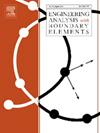Employ a multigrid algorithm to solve the shape-transformation phase-field model
IF 4.1
2区 工程技术
Q1 ENGINEERING, MULTIDISCIPLINARY
Engineering Analysis with Boundary Elements
Pub Date : 2025-10-10
DOI:10.1016/j.enganabound.2025.106501
引用次数: 0
Abstract
This paper presents an original three-dimensional shape-transformation phase-field model solved by a highly efficient, optimally complex multigrid algorithm. The model extends the classical Allen–Cahn equation through the novel introduction of a static coupling term, , which forces alignment to a target phase while preserving interface sharpness via a localization factor that vanishes at equilibrium (). We develop a customized V-cycle multigrid solver with four key components: (1) Gauss–Seidel relaxation for high-frequency error damping, (2) residual computation, (3) restriction operators, and (4) prolongation operators. For stability and efficiency, an operator-splitting technique decouples nonlinear diffusion and coupling terms, solved sequentially. Rigorous theoretical analysis proves -stability under a time-step constraint and establishes Q-linear convergence of Newton-multigrid iterations. Numerical experiments demonstrate similarity in topology-changing transformations, confirming the method’s robustness and computational superiority.
采用多网格算法求解形状变换相场模型
本文提出了一种新颖的三维形状变换相场模型,该模型采用一种高效、最优复杂的多重网格算法求解。该模型通过引入新颖的静态耦合项α|ϕ2−1|2(ψ−ϕ)扩展了经典的Allen-Cahn方程,该耦合项通过在平衡状态(ϕ=±1)消失的定位因子强制对准目标相位,同时保持界面的锐利度。我们开发了一个定制的v周期多网格求解器,它包含四个关键组件:(1)用于高频误差阻尼的Gauss-Seidel松弛,(2)残差计算,(3)限制算子,(4)延长算子。为了稳定性和效率,算子分裂技术将非线性扩散和耦合项解耦,顺序求解。严格的理论分析证明了时间步长约束下的l2 -稳定性,建立了牛顿-多网格迭代的q -线性收敛性。数值实验表明,拓扑变换的相似性达到99%,验证了该方法的鲁棒性和计算优势。
本文章由计算机程序翻译,如有差异,请以英文原文为准。
求助全文
约1分钟内获得全文
求助全文
来源期刊

Engineering Analysis with Boundary Elements
工程技术-工程:综合
CiteScore
5.50
自引率
18.20%
发文量
368
审稿时长
56 days
期刊介绍:
This journal is specifically dedicated to the dissemination of the latest developments of new engineering analysis techniques using boundary elements and other mesh reduction methods.
Boundary element (BEM) and mesh reduction methods (MRM) are very active areas of research with the techniques being applied to solve increasingly complex problems. The journal stresses the importance of these applications as well as their computational aspects, reliability and robustness.
The main criteria for publication will be the originality of the work being reported, its potential usefulness and applications of the methods to new fields.
In addition to regular issues, the journal publishes a series of special issues dealing with specific areas of current research.
The journal has, for many years, provided a channel of communication between academics and industrial researchers working in mesh reduction methods
Fields Covered:
• Boundary Element Methods (BEM)
• Mesh Reduction Methods (MRM)
• Meshless Methods
• Integral Equations
• Applications of BEM/MRM in Engineering
• Numerical Methods related to BEM/MRM
• Computational Techniques
• Combination of Different Methods
• Advanced Formulations.
 求助内容:
求助内容: 应助结果提醒方式:
应助结果提醒方式:


